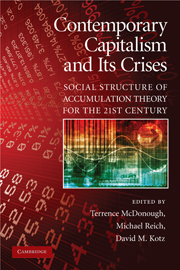Book contents
- Frontmatter
- Contents
- List of Tables
- List of Figures
- List of Contributors
- Acknowledgments
- Introduction: Social Structure of Accumulation Theory for the 21st Century
- PART I THE THEORY OF SOCIAL STRUCTURES OF ACCUMULATION
- 1 The State of the Art of Social Structure of Accumulation Theory
- 2 Social Structure of Accumulation Theory
- 3 A Reconceptualization of Social Structure of Accumulation Theory
- PART II GLOBALIZATION AND THE CONTEMPORARY SOCIAL STRUCTURE OF ACCUMULATION
- PART III THE CONTEMPORARY SOCIAL STRUCTURE OF ACCUMULATION IN THE UNITED STATES
- PART IV SOCIAL STRUCTURE OF ACCUMULATION THEORY AND TRANSFORMATIONS OF THE CAPITALIST PERIPHERY
- Index
- References
2 - Social Structure of Accumulation Theory
Published online by Cambridge University Press: 05 June 2012
- Frontmatter
- Contents
- List of Tables
- List of Figures
- List of Contributors
- Acknowledgments
- Introduction: Social Structure of Accumulation Theory for the 21st Century
- PART I THE THEORY OF SOCIAL STRUCTURES OF ACCUMULATION
- 1 The State of the Art of Social Structure of Accumulation Theory
- 2 Social Structure of Accumulation Theory
- 3 A Reconceptualization of Social Structure of Accumulation Theory
- PART II GLOBALIZATION AND THE CONTEMPORARY SOCIAL STRUCTURE OF ACCUMULATION
- PART III THE CONTEMPORARY SOCIAL STRUCTURE OF ACCUMULATION IN THE UNITED STATES
- PART IV SOCIAL STRUCTURE OF ACCUMULATION THEORY AND TRANSFORMATIONS OF THE CAPITALIST PERIPHERY
- Index
- References
Summary
SSA Theory and Its Origins
Social Structure of Accumulation (SSA) theory seeks to explain the long waves – averaging about fifty or sixty years for a complete cycle – that have characterized capitalist economic growth, and the distinct stages of capitalism that have marked each long upswing. Thus, in the United States, the upswing early in the twentieth century was marked by industrial consolidation, mass production, and the introduction of “scientific management.” The SSA following World War II was marked by the growth of the state, U.S. leadership in the world economy, limited competition and tacit “accords” between capital and labor on the one hand and between capital and the citizenry on the other. This second SSA is analyzed in greater detail later as a means of supporting and clarifying the theoretical argument presented here.
The focus of SSA theory is on the institutional arrangements that help to sustain long-wave upswings. Institutions can be thought of in a narrow sense as organizations (like universities or the World Bank), or in a broader sense as made up of customs, habits, and expectations. In this sense, they are typically country- or culture-specific. A further division can be made within the broader sense, which might refer to something rather specific like collective bargaining on the one hand or more broadly to the entire system of labor relations that exists within a country.
- Type
- Chapter
- Information
- Contemporary Capitalism and its CrisesSocial Structure of Accumulation Theory for the 21st Century, pp. 45 - 71Publisher: Cambridge University PressPrint publication year: 2010
References
- 17
- Cited by



